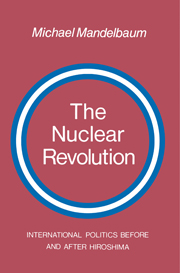Book contents
- Frontmatter
- Contents
- Preface
- 1 The nuclear revolution
- 2 Nuclear weapons and chemical and biological weapons
- 3 The balance of power in the nuclear age
- 4 Arms competition: The nuclear arms race and the Anglo–German naval rivalry
- 5 Arms competition: The nuclear arms race and tariff competitions
- 6 NATO: The nuclear alliance
- 7 The nuclear presidency
- 8 The bomb, dread, and eternity
- Notes
- Index
3 - The balance of power in the nuclear age
Published online by Cambridge University Press: 26 January 2010
- Frontmatter
- Contents
- Preface
- 1 The nuclear revolution
- 2 Nuclear weapons and chemical and biological weapons
- 3 The balance of power in the nuclear age
- 4 Arms competition: The nuclear arms race and the Anglo–German naval rivalry
- 5 Arms competition: The nuclear arms race and tariff competitions
- 6 NATO: The nuclear alliance
- 7 The nuclear presidency
- 8 The bomb, dread, and eternity
- Notes
- Index
Summary
The balance of power
Like disarmament, the balance of power is a systemic response to the need for order. Unlike disarmament, the balance of power cuts with rather than against the grain of international politics. Disarmament would require the restructuring of the international system according to the principle of hierarchy. The balance of power takes advantage of the system's natural anarchy, and of the impulses for self-aggrandizement and selfdefense to which anarchy lends itself. Rather than calling for a drastic change in the way that states conduct their affairs, the balance of power, defined as the tendency of the international system toward an equilibrium in which no single state dominates the others, is a means by which the characteristic behavior of states yields a kind of harmony. It is an ancient feature of politics among sovereign political communities, which the nuclear revolution has helped to revive.
Thucydides records three occasions on which efforts to establish hegemony were thwarted. As his story begins, a coalition of Greek city–states has repelled an invasion by Persia. Then, when the Athenians bid to dominate Greece, other city–states coalesce to stop them.
So finally the point was reached when Athenian strength attained a peak plain for all to see and the Athenians began to encroach upon Sparta's allies. It was at this point that Sparta felt the position to be no longer tolerable and decided by starting this present war to employ all her energies in attacking and, if possible, destroying the power of Athens.
- Type
- Chapter
- Information
- The Nuclear RevolutionInternational politics Before and after Hiroshima, pp. 51 - 86Publisher: Cambridge University PressPrint publication year: 1981



